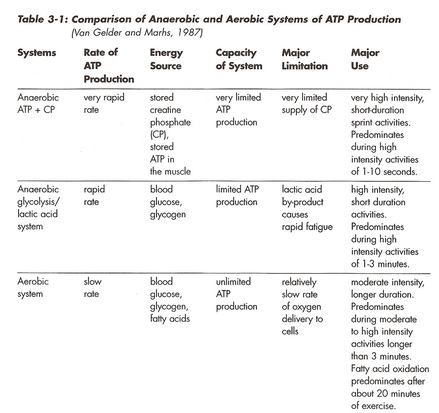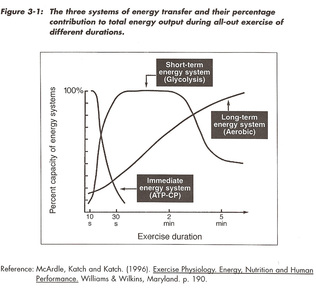|
Since indoor cycling’s main focus is on cardiovascular conditioning, we need to use our knowledge of the body’s energy systems to our advantage. In three separate blog posts, I will review these energy systems and how we can focus on them during an indoor cycling class. Have you heard of Metabolic Training? Well, it’s the term used to describe workouts based on the body’s energy systems. So, we are talking about metabolic training with each post, but I did not want to start with too much terminology right of the bat! Let’s go back to basics. Our body is an amazing system for generating the energy that allows us to move. Adenosine Triphosphate (ATP) is a substance the body uses to store and move energy. Your cells break down ATP when they require energy. Depending on the energy system, ATP is either formed from the breakdown of glucose with oxygen (aerobic) or without oxygen (anaerobic). This first post will focus on the aerobic energy system. I like to think of the aerobic energy system (sometimes called aerobic respiration) as the endurance system. Definitely something that is important for us within an indoor cycling class. Our bodies tend to tap into the aerobic energy system after three minutes of exercise (the systems used in the first few minutes will be more the subject of my next posts) and use it as the primary means of energy over the long haul. The aerobic energy system is able to generate large amounts of ATP but is also relatively sluggish compared to other energy systems. It takes a while to kick in. This is because it involves many steps and continuously requires oxygen and other nutrients. As long as oxygen is available, a muscle cell will continue to use the aerobic energy system as much as possible to contract and relax muscle fibers. Thus, prolonged exercise where the demand on your body does not exceed the ability of this system to provide energy will use the aerobic energy system almost exclusively. In fact, in well-conditioned individuals (like yourself!), the aerobic energy system alone will provide the energy to continue for many hours at a low to moderate intensity! So how do we apply our knowledge of the aerobic energy system to our drills? Well, let’s look at the appropriate work to rest ratio, which is the time it takes our bodies to recovery from aerobic work. For aerobic work, we must design sessions with the ratios 1:1 (equal parts work and rest) to 1:0.5 (work double the amount of the time we rest). With fall now here and new classes starting, try this icebreaker drill to incorporate aerobic intervals. Split the group into three groups but also ask cycle participants to partner up within those groups and get to know their fellow cycle mate. Group sizes will depend on the number of participants. For example, in the studio I teach in, there are six rows of six bikes. The first group would be rows #1 and #2, the second group would be rows #3 and #4, and finally, the third group would be rows #5 and #6. WORK: 3 minutes of riding steady state pace (RPE = 3/10). Partners learn each other’s name. Then one partner asks questions to learn more about their partner like: how many indoor cycling classes they've done before and why they are taking the class, etc. REST: 90 second light spin out (RPE = 1-2/10). Have the first group introduce their partner by name to the class. WORK: 3 minutes of riding steady state pace (RPE = 3/10). With the same partners, switch which partner is asking questions and learning about their new classmate. REST: 90 second light spin (RPE = 1-2/10) second group introduce their partner by name. WORK: Up the ante! 4 minute ride just over steady state (increase resistance) by a gear (one or two notches) or increase tension knob until there is a noticeable increase (RPE = 4/10). Have partners find out about one unusual/unique thing about their partner. REST: 90 second light spin (RPE = 1-2/10) third group introduce their partner by name. After this, all participants should have been introduced. Since aerobic work can be slightly dull and boring (no high energy sprints here!) figure out ways to engage cycle participants while they do their steady state work. Be creative. Try “name that tune” over a 3-6 minute time period and allocate points to those who are the first to answer right. Use the recovery/rest period to tally the points. Or, pick up a deck of Trivial Pursuit cards and complete six intervals to cover the six topic areas. Again use the rest period to tally points. Fun and creativity keeps your cycle participants engaged during long aerobic work. The ultimate goal is to demonstrate that this type of work using the aerobic energy system allows them to talk and interact without difficulty! It is an intensity that is moderate to somewhat hard. So try the aerobic energy system drills early on as they will soon be progressing to hard drills (aka the anaerobic work!) with less opportunity for this kind of fun interaction! Stay tuned - there is more to come on the other two main energy systems – the anaerobic lactic energy system and the anaerobic alactic energy system. Postscript: I found this great YouTube video that helps demonstrate the energy system process. Enjoy!
4 Comments
10/3/2012 09:40:30 pm
Excellent job! Keep sharing such valuable information through your blogs.
Reply
Lisa
1/13/2021 10:04:29 am
Thanks for the feedback Arnold!
Reply
Leave a Reply. |
Workman's Cycle Drills & Skills
Enjoy some of my favorite cycle workout drills either in a cycle class or on your own bike at home! Archives
September 2013
Categories
All
|
Edmonton, Alberta


 RSS Feed
RSS Feed